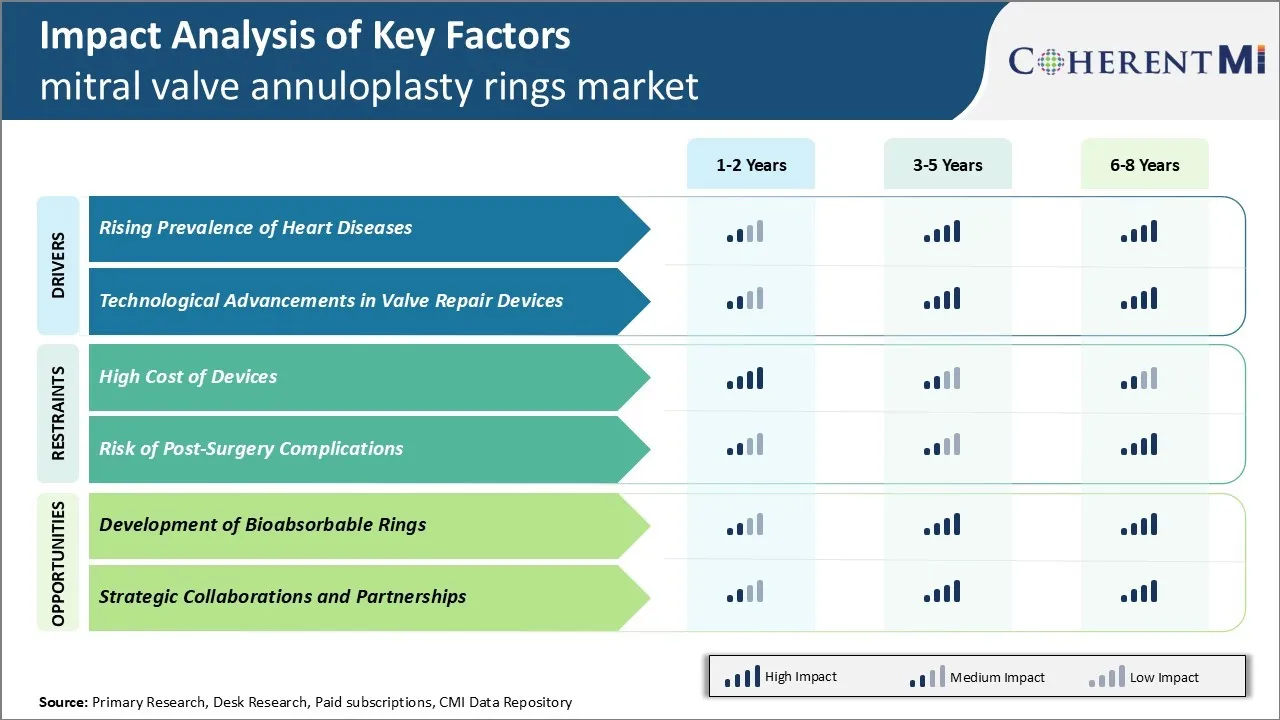Mitral Valve Annuloplasty Rings Market Trends
Market Driver - Rising Prevalence of Heart Diseases
Heart disease has emerged as one of the leading causes of death and disability worldwide. The rising prevalence of unhealthy lifestyles such as lack of physical activity, smoking, excessive alcohol consumption and poor dietary habits have significantly contributed to the increasing incidence of cardiovascular diseases. According to WHO, cardiovascular diseases accounted for approximately 17.9 million deaths in 2019, representing 32% of all global deaths. Diseases affecting valves in the heart such as mitral regurgitation and mitral stenosis are also on the rise. The increasing geriatric population base prone to degenerative valve diseases also adds to the growing burden. As per some studies, more than 15 million people in the United States suffer from various heart valve diseases currently.
Mitral regurgitation, which affects the ability of the mitral valve to close properly and prevent blood from flowing backward from the left ventricle to the left atria, is one of the most common types of valvular heart diseases. Symptomatic severe mitral regurgitation requires surgery to repair or replace the mitral valve to prevent further complications. The rising incidence of mitral regurgitation has led to a substantial increase in the number of mitral valve repair and replacement surgeries performed globally. Mitral Valve Annuloplasty Rings are an integral part of these surgeries as they help reshape and stabilize the mitral valve annulus, thereby restoring the normal function of the mitral valve. So, the growing patient pool of heart valve diseases, especially mitral regurgitation, has fuelled the demand for Mitral Valve Annuloplasty Rings in recent years.
Technological Advancements in Valve Repair Devices
The mitral valve annuloplasty ring Market has witnessed significant technological innovations over the past few decades. Advancements in materials used for ring construction, ring design and delivery techniques have improved clinical outcomes and expanded the procedural options. Early rigid rings made from non-corrosive metals like stainless steel have now been replaced by flexible rings made of polymers, composites and decellularized pericardial tissues. The newer rings conform better to the dynamic annulus and mimic the natural flexibility of mitral valve for improved haemodynamics. Besides, advanced designs like asymmetric and saddle-shaped rings have enabled repair of more complex valve abnormalities with greater success.
Innovations have also occurred in ring delivery systems. Traditionally, rings required an open-heart surgical approach but newer transcatheter delivery options using catheters and guidewires have emerged. Minimally-invasive procedures using these innovative delivery platforms are associated with reduced recovery times, hospital stay and costs. Some companies have also developed fully-automated robotic systems integrated with advanced visualization tools to facilitate precise placement of rings. Such technological marvels are set to transform mitral valve therapies. Newer studies evaluating the long-term performance of technologically advanced rings will further boost physician and patient confidence in valve repair procedures. The continuous introduction of novel products with superior performance attributes will sustain Market growth in the near future.

Market Challenge - High Cost of Devices
One of the major challenges faced by the Mitral Valve Annuloplasty Rings Market is the high cost of the devices. Mitral Valve Annuloplasty Rings are classified as Class III medical devices by the FDA, which requires extensive clinical evaluation. This makes the approval process long and expensive. Device manufacturers need to invest heavily in R&D to develop new and innovative ring designs. Clinical trials involving a large patient cohort need to be conducted to test the safety and efficacy of these devices. The stringent regulatory requirements significantly drive up the development costs. Once approved, the high manufacturing costs associated with making these custom-fitted biocompatible rings from medical-grade materials are passed on to healthcare providers and patients. The high price of the devices is a major barrier for their widespread adoption, especially in developing Markets with cost containment pressures. This cost challenge threatens the growth potential of the Mitral Valve Annuloplasty Rings Market. Device makers need to explore ways to reduce production costs through process optimization and scaling up operations, in order to make these life-saving devices accessible to more patients.
Market opportunities - Development of Bioabsorbable Rings
One of the key opportunities for the Mitral Valve Annuloplasty Rings Market is the development of fully bioabsorbable ring designs. Currently, most annuloplasty rings used in surgeries are made of permanent materials like woven polyester that must remain in the body lifelong. This raises concerns about potential long-term complications, restricts cardiac imaging follow-ups, and requires additional surgery for removal if needed. Bioabsorbable rings made from materials that safely disintegrate in the body over time could address these issues. Considerable research efforts are ongoing to develop rings with degradation properties matched to tissue healing. Once approved, bioabsorbable rings may curb reoperation rates and improve treatment outcomes. They can expand access to annuloplasty therapy in younger patient groups. This innovative product category represents a major growth avenue for Market players. Success in commercializing fully absorbable mitral therapies can lead to significant gains in Market share and help counter pricing pressures from cost-sensitive Markets.